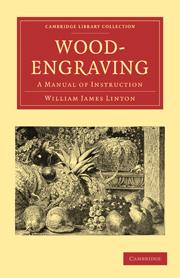Book contents
- Frontmatter
- PREFACE
- Contents
- ILLUSTRATIONS
- CHAPTER I Of engraving in relief
- CHAPTER II Of the history of Wood-Engraving
- CHAPTER III Of the difference between cutting and engraving
- CHAPTER IV Of the tools required for engraving on wood
- CHAPTER V Of drawing on wood for engraving
- CHAPTER VI Of the method of procedure in engraving
- CHAPTER VII Of things to be avoided
- CHAPTER VIII Of things to be aimed at
- CHAPTER IX Of beauty of line
- CHAPTER X Of the use and abuse of photography
- CHAPTER XI Of what constitutes an Artist
- CHAPTER XII of works for reference
- Index
- Plate section
CHAPTER VIII - Of things to be aimed at
Published online by Cambridge University Press: 29 August 2010
- Frontmatter
- PREFACE
- Contents
- ILLUSTRATIONS
- CHAPTER I Of engraving in relief
- CHAPTER II Of the history of Wood-Engraving
- CHAPTER III Of the difference between cutting and engraving
- CHAPTER IV Of the tools required for engraving on wood
- CHAPTER V Of drawing on wood for engraving
- CHAPTER VI Of the method of procedure in engraving
- CHAPTER VII Of things to be avoided
- CHAPTER VIII Of things to be aimed at
- CHAPTER IX Of beauty of line
- CHAPTER X Of the use and abuse of photography
- CHAPTER XI Of what constitutes an Artist
- CHAPTER XII of works for reference
- Index
- Plate section
Summary
THE drawing you have to engrave may be an original design drawn on the block by the designer, yourself or another, or it may be the copy of some picture.
If the drawing be your own, and of your own designing, surely you know your own intention, and can have little hesitation as to the manner of treating it in engraving: that is, supposing you have carefully studied the different details of your art, have learned how to manage your graver, have obtained certainty of hand whether to cut a white line or to leave a black one to the form and size you desire; and if you have learned also to estimate the relative value of lines in contrast with each other for expression of differences of substance, or of gradations of colour in your tints. These things mastered, you are qualified to engrave whatever drawing you are capable of making. Aim now at such combination of these things as will produce a perfect work: a work in which the parts accord, in which one part shall not, however well cut, be too coarse or too fine for another, in which distances shall be preserved, colour attended to, forms well denned, and (if the size of the subject allow it) the differences of substance distinctly expressed. Care for fitness and appropriateness in everything! Do not cut a sky with a rough line as if it were a piece of rugged rock; or a piece of broken ground or rock with a smooth straight line, trusting only to colour to express unevenness.
- Type
- Chapter
- Information
- Wood-EngravingA Manual of Instruction, pp. 72 - 80Publisher: Cambridge University PressPrint publication year: 2010First published in: 1884

